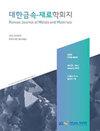利用COMSOL建立镁电解新工艺数值分析模型
IF 1.1
4区 材料科学
Q4 MATERIALS SCIENCE, MULTIDISCIPLINARY
引用次数: 0
摘要
镁(Mg)具有良好的物理性能,包括重量轻、比强度高和刚度高,在许多领域都有应用。但目前镁的生产方法存在缺点,如产生氧化硫和氯气。在这种情况下,韩国地球科学与矿产资源研究所(KIGAM)开发了一种使用液态金属阴极的熔盐电解法(MSELMC)来生产高纯度镁。MSE-LMC方法通过在1053-1083K下电解溶解在(MgF2)-LiF熔盐中的MgO,并在1200-1300K下真空蒸馏与金属液体阴极反应生成的合金,可以获得99.998-99.999%的高纯度镁。本研究使用COMSOL Multiphysics电沉积模块开发了一个数值分析模型,以优化电解过程的设计。模型温度为1053K,熔盐为54MgF2-46LiF,MgO体系为0.6wt%。在阳极处施加10A的恒定电流。该模型使用巴特勒·沃尔默方程和能斯特方程进行电反应。用斯托克斯-爱因斯坦方程和能斯特-爱因斯坦关系式计算了盐的扩散率和电迁移率。与实验不同的是,在这个模型中产生了氯气。然而,这个模型满足了法拉第定律。因此,我们定义了一个新的参数,利用电流和电压根据电极形状进行定量评估,并通过阳极角度的变化来比较该参数。本文章由计算机程序翻译,如有差异,请以英文原文为准。
Development of Numerical Analysis Model for New Magnesium Electrolysis Process Using COMSOL
Magnesium (Mg) has good physical properties including light weight, excellent specific strength and high stiffness, and Mg is used in many fields. But current production methods of Mg have disadvantages, such as the generation of sulfur oxide and chlorine gas. In this situation, The Korea Institute of Geoscience and Mineral Resources (KIGAM) developed a Molten Salt Electrolysis Using Liquid Metal Cathode (MSELMC) method to produce high-purity magnesium. The MSE-LMC method can obtain 99.998-99.999% highpurity magnesium by the electrolysis of MgO dissolved in (MgF2)-LiF molten salt at 1053-1083 K, and by vacuum distilling an alloy generated by reacting with a metallic liquid cathode at 1200-1300 K. This study developed a numerical analysis model using COMSOL Multiphysics electrodeposition module to optimize the design of the electrolysis process. The model temperature was 1053K and molten salt was 54MgF2-46LiF with a 0.6wt% MgO system. 10A constant current was applied at the anode. This model uses the Butler-Volmer equation and the Nernst equation for the electric reaction. The Stokes-Einstein equation and Nernst-Einstein relation were used to calculate the diffusivity and electric mobility of salts. Unlike the experiment, in this model chlorine gas was generated. However, this model satisfied Faraday’s law. Therefore we define a new parameter using electric flux and voltage to conduct a quantitative evaluation according to the electrode shape, and compared that parameter by the changing angle of the anode.
求助全文
通过发布文献求助,成功后即可免费获取论文全文。
去求助
来源期刊

Korean Journal of Metals and Materials
MATERIALS SCIENCE, MULTIDISCIPLINARY-METALLURGY & METALLURGICAL ENGINEERING
CiteScore
1.80
自引率
58.30%
发文量
100
审稿时长
4-8 weeks
期刊介绍:
The Korean Journal of Metals and Materials is a representative Korean-language journal of the Korean Institute of Metals and Materials (KIM); it publishes domestic and foreign academic papers related to metals and materials, in abroad range of fields from metals and materials to nano-materials, biomaterials, functional materials, energy materials, and new materials, and its official ISO designation is Korean J. Met. Mater.
 求助内容:
求助内容: 应助结果提醒方式:
应助结果提醒方式:


